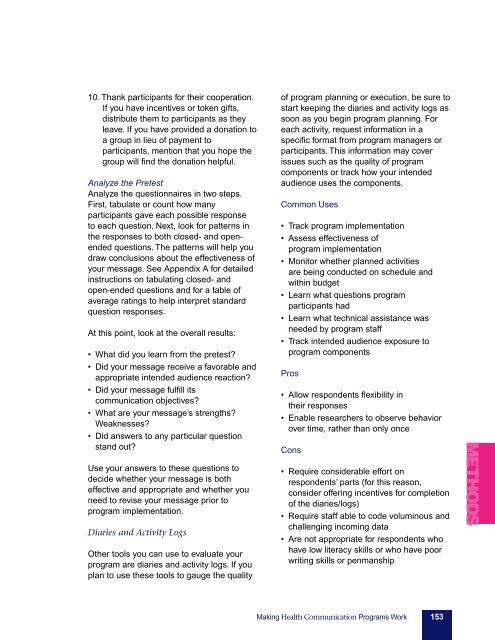pink-book
pink-book
pink-book
Create successful ePaper yourself
Turn your PDF publications into a flip-book with our unique Google optimized e-Paper software.
10. Thank participants for their cooperation.<br />
If you have incentives or token gifts,<br />
distribute them to participants as they<br />
leave. If you have provided a donation to<br />
a group in lieu of payment to<br />
participants, mention that you hope the<br />
group will find the donation helpful.<br />
Analyze the Pretest<br />
Analyze the questionnaires in two steps.<br />
First, tabulate or count how many<br />
participants gave each possible response<br />
to each question. Next, look for patterns in<br />
the responses to both closed- and openended<br />
questions. The patterns will help you<br />
draw conclusions about the effectiveness of<br />
your message. See Appendix A for detailed<br />
instructions on tabulating closed- and<br />
open-ended questions and for a table of<br />
average ratings to help interpret standard<br />
question responses.<br />
At this point, look at the overall results:<br />
• What did you learn from the pretest<br />
• Did your message receive a favorable and<br />
appropriate intended audience reaction<br />
• Did your message fulfill its<br />
communication objectives<br />
• What are your message’s strengths<br />
Weaknesses<br />
• Did answers to any particular question<br />
stand out<br />
Use your answers to these questions to<br />
decide whether your message is both<br />
effective and appropriate and whether you<br />
need to revise your message prior to<br />
program implementation.<br />
Diaries and Activity Logs<br />
Other tools you can use to evaluate your<br />
program are diaries and activity logs. If you<br />
plan to use these tools to gauge the quality<br />
of program planning or execution, be sure to<br />
start keeping the diaries and activity logs as<br />
soon as you begin program planning. For<br />
each activity, request information in a<br />
specific format from program managers or<br />
participants. This information may cover<br />
issues such as the quality of program<br />
components or track how your intended<br />
audience uses the components.<br />
Common Uses<br />
• Track program implementation<br />
• Assess effectiveness of<br />
program implementation<br />
• Monitor whether planned activities<br />
are being conducted on schedule and<br />
within budget<br />
• Learn what questions program<br />
participants had<br />
• Learn what technical assistance was<br />
needed by program staff<br />
• Track intended audience exposure to<br />
program components<br />
Pros<br />
• Allow respondents flexibility in<br />
their responses<br />
• Enable researchers to observe behavior<br />
over time, rather than only once<br />
Cons<br />
• Require considerable effort on<br />
respondents’ parts (for this reason,<br />
consider offering incentives for completion<br />
of the diaries/logs)<br />
• Require staff able to code voluminous and<br />
challenging incoming data<br />
• Are not appropriate for respondents who<br />
have low literacy skills or who have poor<br />
writing skills or penmanship<br />
METHODS<br />
Making Health Communication Programs Work 153


